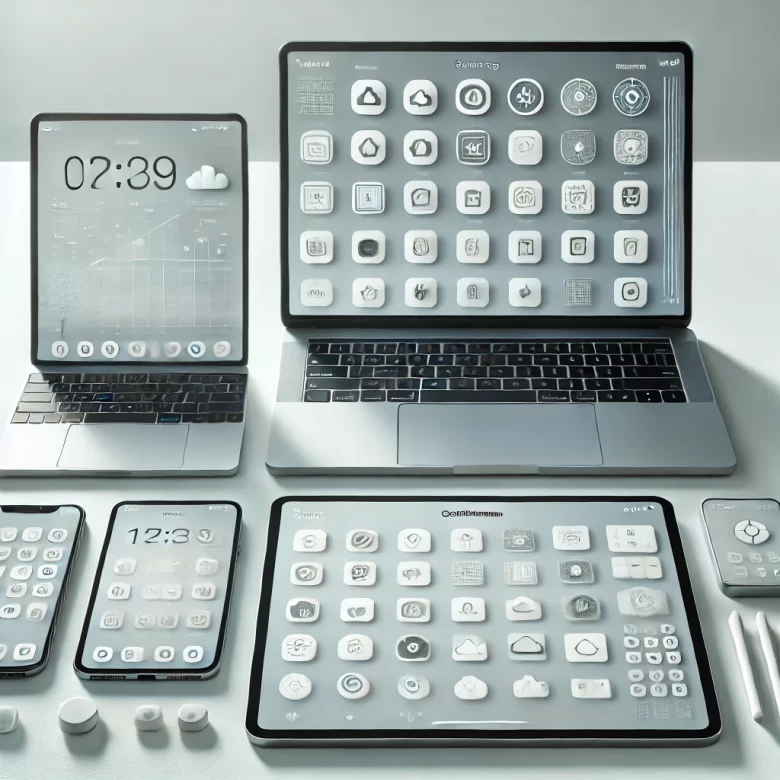Introduction
In today’s digital age, we are surrounded by an overwhelming amount of information, files, and notifications. Our devices are filled with apps, documents, and media that can easily lead to digital clutter. Just as we organize our physical spaces, it’s crucial to organize our digital lives as well. By eliminating digital excess and streamlining the way we use our devices, we can improve efficiency, reduce stress, and create a more focused, productive digital environment. This article explores practical steps to help you eliminate digital clutter and organize your devices for maximum efficiency.
Why Digital Organization Matters
Digital organization may seem like a minor task compared to physical organization, but the impact of digital clutter can be just as significant—if not more. Disorganized devices and excessive digital files can lead to several challenges:
- Decreased Productivity: Cluttered devices make it harder to find important files and apps, wasting time that could be spent on more important tasks.
- Increased Stress: Digital overload, such as excessive notifications or disorganized folders, can contribute to anxiety and feelings of being overwhelmed.
- Reduced Efficiency: With an excess of files, apps, and data, devices become slower, making it harder to stay productive.
By eliminating digital excess, you can create a more organized and efficient digital workspace that enhances both your focus and productivity.
Steps to Eliminate Digital Excess and Organize Your Devices
Declutter Your Devices
The first step in organizing your devices is to eliminate unnecessary files, apps, and notifications. This helps create a cleaner, more streamlined environment.
- Delete Unused Apps: Go through your phone, tablet, and computer to remove apps that you no longer use. These take up valuable space and contribute to clutter. Only keep apps that serve a functional purpose or bring value to your daily life.
- Clean Up Files and Documents: Organize your documents into clearly labeled folders and delete any files that are no longer needed. Use a system that makes sense to you, such as categorizing files by type, project, or date.
- Remove Old Photos and Videos: We often store countless photos and videos on our devices that we rarely revisit. Back them up to the cloud or an external hard drive and delete any duplicates or irrelevant files.
- Unsubscribe from Unwanted Emails: Regularly unsubscribe from newsletters and promotional emails that you no longer find useful. Consider using an email management app to help keep your inbox clean and organized.
Organize Your Files and Folders
Once you’ve eliminated unnecessary items, it’s time to create an efficient file organization system. A well-organized file structure allows you to quickly find what you need, saving time and reducing frustration.
- Create Clear Folder Hierarchies: Organize your files into main categories, such as “Work,” “Personal,” “Finance,” and “Projects.” Inside each category, create subfolders for more specific areas, like “Reports” or “Invoices.”
- Use Descriptive File Names: Instead of generic names like “Document1,” use clear and descriptive file names that make it easy to identify what the file contains. For example, name files with a project title and date: “ClientReport_2025_03_15.”
- Regularly Clean and Archive: Set a recurring reminder to clean out old files and archive completed projects. This will prevent your devices from becoming cluttered again over time.
Manage Your Apps Efficiently
We often have many apps on our devices, but we don’t always use them effectively. Organizing your apps can improve your productivity and make it easier to access the tools you need when you need them.
- Group Similar Apps Together: Organize your apps into folders based on their function, such as “Productivity,” “Social Media,” “Finance,” and “Entertainment.” This makes it easy to find the app you need without wasting time searching through a sea of icons.
- Use App Prioritization: Keep the apps you use most frequently on your home screen, and move less important ones to secondary screens or into folders. This reduces clutter and makes it easier to access your essential tools quickly.
- Remove or Disable Unused Apps: If there are apps you no longer use, delete them. For apps that you don’t want to completely remove but rarely use, consider disabling or hiding them to free up space and reduce distractions.
Optimize Cloud Storage
- Cloud storage is a powerful tool for organizing your digital life, but it can also become overwhelming if not properly managed. Properly using cloud storage helps free up space on your devices and ensures your files are easily accessible from anywhere.
- Organize Files in the Cloud: Just as you would on your local device, organize files in your cloud storage into well-labeled folders. This ensures that you can easily access and find what you need, no matter where you are.
- Sync Devices for Easy Access: Enable synchronization across all your devices so that files and documents are consistently updated and accessible from any device.
- Free Up Space Locally: Store files you don’t need immediate access to in the cloud, freeing up space on your devices. This can help improve your device’s performance and reduce digital clutter.
Streamline Notifications and Alerts
Constant notifications from apps, emails, and social media can disrupt your focus and add to the feeling of digital overwhelm. Managing your notifications can help you stay on track and reduce distractions.
- Turn Off Non-Essential Notifications: Review the notifications on your phone and computer, and turn off those that aren’t essential. Limit notifications to only the most important alerts, such as work emails or reminders.
- Use “Do Not Disturb” Mode: When you need to focus, use “Do Not Disturb” mode to temporarily silence notifications. This is especially helpful during work hours or when you need uninterrupted time for a task.
- Set Notification Schedules: Consider setting specific times during the day when you check your emails or social media. This will help you stay focused and prevent distractions from constant notifications.
Maintain Regular Digital Cleanups
Digital organization is an ongoing process. To keep your devices running efficiently and avoid accumulating excess digital clutter, it’s important to make digital cleanups a regular habit.
- Set a Monthly Reminder: Schedule a monthly reminder to review your devices, delete unused apps, organize files, and clean up email subscriptions.
- Review Cloud Storage Annually: At least once a year, go through your cloud storage to archive old files and delete anything no longer needed. This will keep your cloud environment organized and efficient.
Declutter Your Desktop and Home Screens
A cluttered desktop or home screen can be a major source of stress. It’s often the first thing you see when you open your computer or phone, and a disorganized space can impact your mindset for the day. Creating a clean and organized digital workspace can significantly improve your productivity.
- Organize Desktop Folders: Just like physical spaces, your computer desktop can quickly become overwhelmed with files, shortcuts, and icons. Start by creating organized folders based on projects or types of files. Limit the number of icons on your desktop to only the most essential shortcuts, such as your favorite apps or frequently used documents.
- Use Virtual Desktops: For those who use Windows or Mac, take advantage of virtual desktops. This allows you to create different workspaces for various tasks—one for personal use, one for work, and another for ongoing projects. This creates a cleaner, more focused environment by keeping everything separated.
- Tidy Your Phone’s Home Screen: Just like your computer, your phone’s home screen can quickly become cluttered with apps. Group similar apps together and consider moving less frequently used apps to a second or third screen. Keep only essential apps that you use daily on your home screen.
Manage Your Digital Notes
Many of us use digital note-taking apps like Evernote, OneNote, or Google Keep to jot down ideas, thoughts, and reminders. While these apps can be helpful, they can also become overwhelming if not properly organized. Having a clear system for managing your notes can help you easily find what you need and keep your digital life organized.
- Create Notebooks for Specific Topics: Group your notes into different notebooks based on categories like “Work,” “Personal,” “Ideas,” or “Goals.” This way, you won’t have to sift through hundreds of individual notes to find what you’re looking for.
- Tag Notes for Easy Search: Most digital note apps allow you to add tags to your notes. Use tags to further categorize your notes and make them easier to search for later. For example, if you have a note about a work project, tag it with “project,” “meeting,” and the project name.
- Delete or Archive Old Notes: Periodically go through your notes and delete anything that is no longer relevant. If you want to keep certain notes for reference but don’t need them in your active folders, consider archiving them.
Limit and Manage Digital Subscriptions
Digital subscriptions—whether for streaming services, newsletters, or software tools—can easily accumulate over time and lead to a cluttered digital space. Managing these subscriptions can help you avoid unnecessary digital clutter and keep your email inbox organized.
- Consolidate Subscriptions: If you have multiple subscriptions for similar services (e.g., multiple cloud storage solutions), consider consolidating them into one. This helps simplify your digital landscape and may even save you money.
- Unsubscribe Regularly: As with emails, review your digital subscriptions periodically and unsubscribe from services or newsletters that you no longer use or find valuable. Set a recurring reminder to unsubscribe from new services as well.
- Organize Subscription Information: Keep track of your active subscriptions with a simple document or a subscription management app. This ensures that you’re aware of the services you’re paying for and prevents unwanted renewals or forgotten subscriptions.
Practice Digital Minimalism
Digital minimalism is a philosophy that advocates for simplifying your digital life by cutting back on unnecessary apps, files, and online activities. Embracing this mindset can help you focus on what truly matters and avoid wasting time on digital distractions.
- Be Intentional with Digital Use: Rather than mindlessly scrolling through social media or checking your phone every few minutes, set intentional time limits for your digital activities. For example, allocate 15 minutes in the morning to check emails, and set aside time in the evening for social media, rather than letting these activities interrupt your day.
- Evaluate Your Digital Environment: Take a look at the apps and digital tools you use daily. Are they all necessary? Do they help you reach your goals, or are they distractions? Cut back on apps that don’t contribute to your personal or professional development and focus on those that truly add value.
- Set Digital Boundaries: Establish clear boundaries around your digital usage, such as turning off notifications during certain hours, or limiting screen time before bed. These boundaries help you stay in control of your digital life rather than letting technology control you.
Regularly Back Up Important Data
While decluttering and organizing your digital life is crucial, it’s also important to make sure that your essential data is safely backed up. Backups protect your important files from data loss, whether due to a malfunction, accidental deletion, or theft.
- Use Multiple Backup Methods: Back up your data using a combination of cloud storage and physical external hard drives. This ensures that your data is accessible even if one method fails.
- Automate Backups: Set up automatic backups for your devices to ensure that your files are regularly saved without requiring manual intervention. Many cloud storage services offer automatic syncing, so your files are always up to date.
- Keep Redundant Copies: For especially important files, such as documents, photos, or personal projects, consider keeping multiple copies in different locations (e.g., both cloud and physical storage).
Conclusion
Eliminating digital excess and organizing your devices efficiently can transform your digital life, making it more streamlined, productive, and less stressful. By decluttering your devices, organizing files, managing notifications, and adopting digital minimalism, you can create an environment that fosters focus, efficiency, and creativity. Regular maintenance, such as organizing your apps and backing up important data, will ensure that your digital space remains clean and functional in the long term. Embrace these practices today and enjoy a more organized, efficient digital life.




